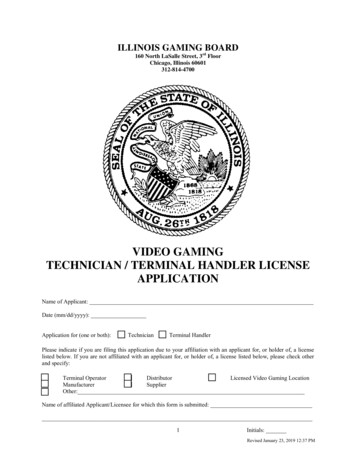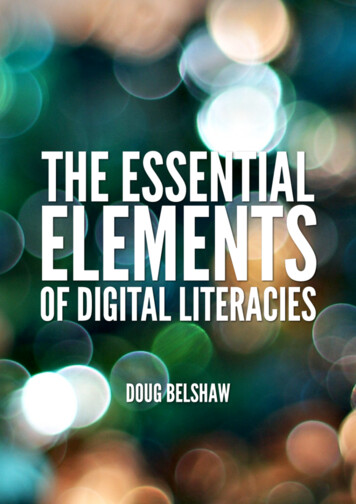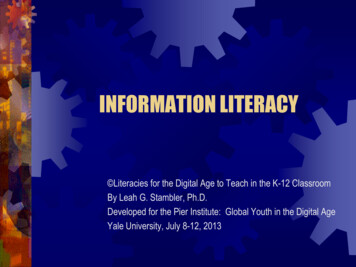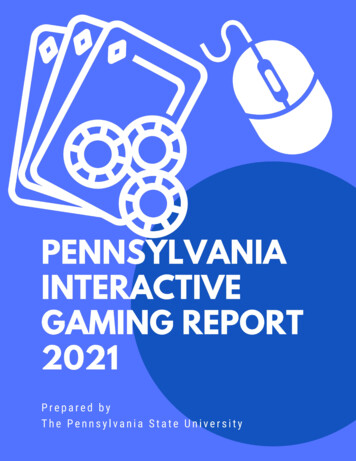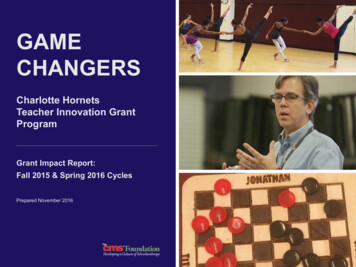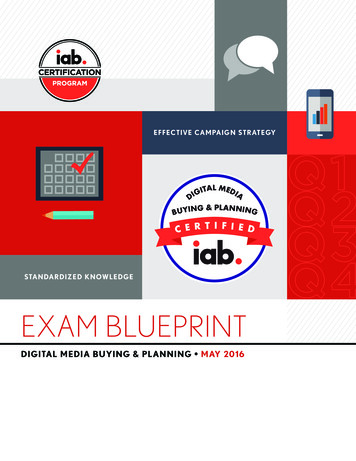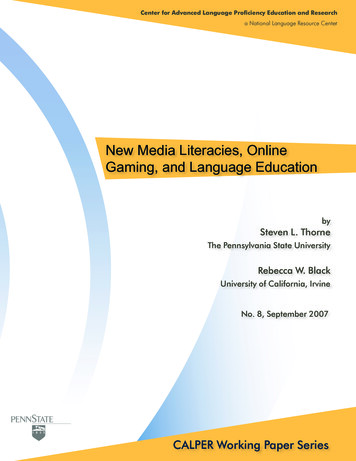
Transcription
Center for Advanced Language Proficiency Education and Researcha National Language Resource CenterNew Media Literacies, OnlineGaming, and Language EducationbySteven L. ThorneThe Pennsylvania State UniversityRebecca W. BlackUniversity of California, IrvineNo. 8, September 2007CALPER Working Paper Series
New Media Literacies, Online Gaming, and Language Education*12Steven L. ThorneThe Pennsylvania State UniversityRebecca W. BlackUniversity of California, IrvineThis paper describes second and foreign language uses of Internet communication tools,web environments, and online gaming, and critically reviews existing research and emerging technologies representing diverse pedagogical conditions in two main areas: (1) interaction in ongoing Internet-mediated environments that include popular culture blogsand web sites, fan fiction communities, language and/or culture communities; and (2)multi-user online games, including a case study of multilingual communication withina gaming environment. We propose that a critical-and-constructive appraisal of existing and emerging digital media, and the communities made possible through them, canhelp to forge more responsive, and more ecologically responsible, language learning opportunities for students living in increasingly mediated social and professional worlds.IntroductionInternet information and communication technologies have amplified conventional communicative practices in the areas of audience, impact, and speed and also have enabledthe emergence of distinctive communicative and cultural practices. The argument developed in this paper is that qualitative shifts in communicative contexts, purposes, andgenres associated with new media necessitate a responsive and proactive vision of educational practice, particularly in the areas of first and additional language instruction.This paper extends earlier treatments of Internet-mediated language education that appear in Kern, Ware, & Warschauer (2004), Kern (2006) and Thorne (forthcoming), and examines affiliative activity, relationship and community building,and identity construction within computer-mediated interaction, either as a design element of formal instruction or as a function of participation in non-institutionally located online environments. In particular, we explore research, pedagogical possibilities, and in some cases informal reports, within the following contexts:1.2.New media studies research examining engagements in Internet-mediated environments thatare not, or are only indirectly, linked to instructed L2 contexts.The potential of massively multi-user online games as sites for intercultural and polylingualcommunication. This latter section will include a case study which examines interactionwithin the popular online game – World of Warcraft (produced by Blizzard Entertainment).* This publication was funded by a grant from the United States Department of Education (CFDA 84.229, P229A060003). However,the contents do not necessarily represent the policy of the Department of Education, and one should not assume endorsement by theFederal Government.1 The contents of this paper draw from and expand upon two forthcoming publications: Thorne, forthcoming, and Thorne & Black,forthcoming. Full citations are available in the references section.2 Please cite as: Thorne, S. L. and Black, R. W. (2007). New Media Literacies, Online Gaming, and Language Education. (CALPER Working Paper Series, No. 8). The Pennsylvania State University: Center for Advanced Language Proficiency Education and Research.
2Thorne and BlackWe restrict this review to computer-mediated language and literacy pedagogy andresearch that explicitly references the developmental potential for second and foreign language learners of social and interactional aspects of online interaction.Communication technologies in contemporary contextsWithin affluent regions of the world and for Internet users everywhere, communicationand social interaction are markedly different today from even a decade ago. Massivesociological analyses have documented that the Internet has qualitatively transformed,with variable consequences, everyday communication and information practices incommercial, financial, professional, educational, recreational, and interpersonal realms(e.g., Castells, 1996; 2004). These late modern conditions raise questions as to how researchers and language educators can orient themselves to the changing qualities,purposes, and contexts of mediated language use generally and toward the issue ofwhich genres and communication tools should be included in instructed L2 curricula.Emerging Internet environments and new media literaciesThe majority of educational research focused on second language acquisition examines development and learning within the tightly bounded confines of classrooms. Yet demonstrably, life and learning are not composed of isolated or strictly isolatable moments and spaces(e.g., Leander & Lovvorn, 2006; Roth et al., 2005; Thorne, 2003). The use of the Internet, bothin and out of school, is expanding rapidly, and often involves participation in communicative genres that differ from analogue-normative epistolary conventions (e.g., Crystal, 2001;Herring, 1996; Thorne & Payne, 2005; Werry, 1996). Although access to communication andinformation technology remains unequally distributed across geopolitical regions and social classes (see Castells, 2004; van Dijk, 2005; Warschauer, 2003), Internet user populationscontinue to expand around the world, significantly increasing the quantity and types ofmedia (text, image, sound, and voice) and forms of participation available (Jenkins, 2006).Emerging literacy practices in online environmentsA great deal of research informed by the New Literacy Studies tradition (NLS) (e.g., Bazerman, 1989; Gee, 1992, 1996; Street, 1995) has clear implications for current understandingsof literacy and language learning as socially and culturally situated, shaped by context,and mediated by various tools and technologies. The NLS notion of multiple literacies,whereby learners develop literacy skills “through multiple experiences, in multiple contexts, with multiple text genres (both oral and written), for multiple purposes” (Kern, 1995,p. 67) is especially relevant to explorations of language practices taking place in out-ofschool, online settings. Moreover, the construct of multiliteracies (Cope & Kalantzis, 2000;New London Group, 1996) has been particularly helpful for exploring communicativecontexts where networked information and communication technologies enable globally distributed individuals to connect using multiple languages and forms of semiotic
CALPER Working Paper Series No. 83mediation. Many of these new literacy practices, such as text messaging, email, chat, andcommunication via avatar, to name just a few, extend beyond traditional print-based text.Much of the scholarship in this area has focused on native speakers using English and other forms of semiotic representation to engage in (potentially new) varietiesof literate interaction in online environments. For example, Lankshear & Knobel (2003;2006) review a range of new language and literacy practices associated with remixingor the “practice of taking cultural artifacts and combining and manipulating them intoa new kind of creative blend” (Lankshear & Knobel, 2006, p. 106). Many types of remixing have arguably become common “writing” practices for a number of youth inonline fan communities (Lessig, 2005 cited in Lankshear & Knobel, 2006). For example,fanfiction is a practice by which fans of various media such as books, movies, television, comics, and video games borrow elements of these popular cultural texts, such ascharacters, settings, plotlines, to name just a few, to construct their own narrative fictions. Fans often remix these various media, combining multiple genres (e.g., creating a“crossover” in which the fiction “crosses over” between a movie and a book), languages,and cultural elements such as inserting Japanese terms and Asian cultural referencesinto Japanese animation or anime-based fanfiction written in English and set within aNorth American story context. Remix practices can also illustrate a plurality of registers, for instance alterations between formal narrative prose and online social registers(see Black, 2005; Lankshear & Knobel, 2006, for examples). Lankshear & Knobel also explore other forms of digital remixing that include the production of anime music videos (AMVs) (combining video and popular music), fan-produced translations and subtitling (combining video, image, and text), and creating amateur manga and/or fan art(combining image and text). Other research has explored how youth use language andnew technologies strategically to strengthen social bonds and articulate their identitiesin online zine and journal communities (Guzzetti & Gamboa, 2005; Lankshear & Knobel,2002), fan sites (Alvermann & Hagood, 2000), and through social networks constructed and maintained via Instant Messaging (Grinter & Palen, 2002; Lewis & Fabos, 2005;Shiu & Lenhart, 2004) as they develop “digital” literacies (Alvermann, 2002) articulatingwith established and emergent cultures-of-use of these Internet communication tools.Multilingual On-Line CommunitiesOf late, there also has been increasing attention paid to the many online literate exchanges taking place in multiple languages, particularly in communities that coalesce aroundpopular and youth culture. For instance, Lam’s (2000; 2004; 2007) work has explored howthe Internet provides new, transnational contexts for immigrant youth’s English identitydevelopment and language socialization. In an early study, Lam described Almon, animmigrant from Hong Kong, who had struggled with English, been tracked as a lowachieving student, and expressed significant trepidation about English, the language ofhis new home in the United States. In high school, however, he began to explore theInternet, developed a web site devoted to the Japanese pop (J-pop) singer Ryoko, andused his knowledge of Japanese popular culture, web design skills, as well as chat andemail to create a textual identity in English. This process was mediated largely in Englishbut also included transcultural expressive features such as emoticons, web page design,
4Thorne and Blackand elements from other languages (e.g., Chinese). The online medium, coupled withhis developing textual identity, bolstered Almon’s confidence in communicating witha supportive, transnational group of peers who shared his interests in popular culture.Moreover, these exchanges also helped him to shift “from a sense of alienation fromthe English language in his adopted country to a newfound sense of expressivity andsolidarity when communicating in English with his Internet peers” (Lam, 2000, p. 468).Commenting on the differences between Almon’s developmental progress in English in school and in the Internet peer group, Lam and Kramsch (2003) argued that although Almon’s textual identity on the Internet was a positive and empowering discursiveformation, his position in the U.S. high school “is also symbolically constructed, this timeas a low-pride ‘low-achiever’” (p. 155). In other words, as Lam and Kramsch note, the sophisticated genre of English language use Almon demonstrated online may not meet theselection criteria necessary to pass the high school exit composition test. This case presentsa number of challenges to the conventional goals and processes of language education,such as the rigidity of the gate keeping mechanisms of high stakes testing, the disconnectbetween the prescriptivist epistemology of schooling and language use that is appropriate in other contexts (Internet-mediated and otherwise), and what should or could bedone to leverage, and perhaps formally acknowledge, a plurality of communicative practices that are currently considered stigmatized linguistic varieties. In an age marked bytranscultural and hybrid genres of communication, these issues will increase in intensityand complexity and must necessarily inform the L2 educational frameworks of the future.In a more recent study, Lam (2004) describes how Yu Qing and Tsu Ying, twoadolescent Chinese emigrants to the U.S. participated in a Chinese/English chatroomand used a hybrid form of English and Romanized Chinese to represent their identities as bilinguals. According to Lam, the hybrid or mixed-code variety of English became an integral part of establishing and maintaining a collective ethnic identity formembers of this community—an identity that followed “neither the social categoriesof English-speaking Americans nor those of Cantonese-speaking Chinese” (p. 45). Suchcode-switching was also used for rhetorical purposes such as expressing humor, relationships, and social roles within the community. Lam’s analysis highlights how the onlineculture of hybrid language use allowed these teens, who felt marginalized from theirnative English-speaking as well as native-born Chinese-American peers in school, to develop confidence and fluency interacting with a transnational group of youth in English.Yi’s (forthcoming; 2007) work explores the multiliterate practices of generation 1.5Korean-American youth in an online community called Welcome to Buckeye City (WTBC).Drawing from ethnographic and case study data, Yi describes how this community servedas a “safe house” (Canagarajah, 1997) for these youth to use their L1 of Korean and L2of English to socialize, compose, relax, and discuss problems from their daily lives. Aunique activity on WTBC was relay writing, whereby members of the site compose a portion of an evolving story and then “relay” the text to the next author (Yi, forthcoming).Much like the Role Play writing of fanfiction authors (Black, forthcoming; Thomas, 2005),this collaborative form of writing “moves beyond the common emphasis on research intoindividual composing in cyberspace and puts a new face on voluntary literacy practices,one that involves students co-constructing knowledge and understanding in a community setting” (Yi, forthcoming, p. 4). By writing with partners and in groups, these youth
CALPER Working Paper Series No. 85are able to engage in purposeful, composition-related interactions, develop metacognitive strategies for monitoring their language use, and gain insight into the social natureof writing (Black, forthcoming).Yi’s case study analysis of Joan, a generation 1.5 Korean-American high schoolstudent in the U.S., reveals how Joan was able to use a wide range of multiliterate composing practices to develop a “writerly” identity in the WTBC community (2007, personal communication). Joan’s prolific writing of poems, short stories, cards, notes, relaynovels, emails, and instant messages provided her with the opportunity to take on subtlydifferent identity roles according to the social and composing settings. By publicly posting her poetry on WTBC, Joan was also able to receive feedback from other membersof the site. This feedback served the multiple purposes of helping Joan to improve hercomposing skills, enabling her to discuss her “adolescent thoughts and feelings” withother immigrant youth, and affirming her identity as an accomplished poet. Additionally, Joan’s frequent instant messaging, chatting, and emailing helped her to developconfidence and fluency in “conversational” English and biliterate writing (Yi, 2007).Black’s (2005; 2006; 2007) empirical investigation of an online fanfiction site alsocenters on the multilingual composing practices of English language learner (ELL) youth.Drawing from a three-year ethnographic project, Black presents case studies of ELLyouth of Asian heritage participating in a Japanese animation (anime) fanfiction writingcommunity. In this work, Black highlights how the cosmopolitan nature of anime-basedfanfiction enabled some ELL focal participants to act as cultural and linguistic “consultants” within the community by helping other fanfiction writers accurately incorporateelements of Asian cultures and languages into their story texts (Black, 2005). Akin toLam’s 2004 study, Black also found that many ELL youth used Romanized Chineseto compose hybrid or multilingual fanfiction texts that incorporated their L1 of Mandarin, L2 of English, and at times additional languages such as Japanese and French.These hybrid texts provided a means for case study participants to index their identities as multilingual and multicultural youth (Black, 2006) and participate via valued language practices that emerged within this specific fandom-inspired speech community.An additional focus of Black’s work is the many ways that online fanfiction-related activity is aligned with school-sanctioned literacy and language development practices, such as collaborative composition, peer-review, peer-editing, and mentoring (Black,2007). For instance, Black describes how the ease of online publication made it possiblefor Nanako, a 16 year-old Mandarin-Chinese high school student who immigrated toCanada at age 11, to revise and repost her fanfiction texts in accordance with audiencefeedback on textual elements such as plot, characterization, and grammar (Black, 2007).Like many fanfiction authors, Nanako also utilized community resources such as online writing guides, composition forums, as well as generic examples from other fanfiction authors to familiarize herself with the associated techniques and conventions ofdifferent genres of writing (Black, 2005). In these ways, Nanako was able not only toimprove her English writing skills but also was able to take on the identity of a popular and accomplished fanfiction author with a broad following of readers. Thus, a common thread across Black, Lam, and Yi’s work is how online communities provide ELLyouth with new forums for taking on powerful authorial and social roles, even as theylearn and develop fluency with multiple textual forms, languages, and online registers.
6Thorne and BlackVirtual environments and gamingIn this section we discuss different varieties of interaction within 3-dimensional computer-rendered environments. One exciting development due to its wide availabilityand relatively low cost is L2 relevant uses of off-the-shelf machine local gaming. A bestselling example is The Sims 2, a game available in multiple languages that simulatesthe routine, and even the mundane, activities of everyday life. In an informal assessment of The Sims 2 as a foreign language learning tool, Purushotma (2005) found thatthe vocabulary and tasks comprising the game were highly aligned with the content ofconventional foreign language course content. Purushotma argues that the differencebetween instructed foreign language learning and a game like The Sims 2 is that exposure to the target language is always linked to carrying out tasks and social actions,which concomitantly embeds vocabulary and grammatical constructions in rich associative contexts. For example, The Sims 2 premise is to use tools within the game to create virtual houses, neighborhoods, communities, and the individuals and families wholive there. Additionally, the families and social communities one creates within TheSims 2 evolve over time and require food, water, sanitation, leisure activities, and thelike. The computer-generated prompts (as mentioned, customizable in a wide number of languages) and messages provide situationally embedded opportunities to learnhigh frequency everyday vocabulary that cover many domestic and social contexts.Other gaming environments leverage the Internet to allow multiple users toplay together at the same time. This variety of multi-user online gaming is closely related to virtual environments such as Second Life, a 3-dimensional visually renderedworld within which structured and unstructured social, professional, and work activity occur. However, there are a number of differences between the two. To take Second Life (www.secondlife.com) as an example of a virtual environment, the computerenabled environment itself does not provide a comprehensive ontology, rather this isproduced by the human players themselves in the form of the objects they create andthe interactions and talk they produce together. Within gaming environments, by contrast, non-human player characters (NPCs) play critical roles such as giving help andassistance, providing instructions for goal-directed tasks (called quests or missions), acting as antagonists in battle, and providing functional services such as, within the gameWorld of Warcraft for example, banking, skills and profession training, transportation,selling goods and materials, armor repair, and the like. In essence, in both gaming andvirtual environment settings, player-to-player communication and interaction is foundational, but gaming involves much more highly structured and goal-directed activity.Increasingly, multi-player online games and virtual environments are coming to the attention of education researchers and practitioners (for a review, see Squire, 2003; see alsoSteinkeuhler, 2004). They have been argued to provide opportunities for immersion inlinguistic, cultural, and task-based settings (Gee, 2003). An array of literacy practiceshave recently emerged that are associated with Massively Multiplayer Online Games(MMOs), video games played online in a persistent virtual world in which individuals interact with other players, not only through voice and in-game chat screens, butalso via digital characters called avatars. Such research has focused on the function and
CALPER Working Paper Series No. 87social norms governing the use of “4337 speak” or “leetspeak” meaning “elite speak,”a specialized form of in-game writing utilizing alphanumeric characters that is used byexperienced players (Black & Steinkuehler, forthcoming; Steinkuehler, 2006). Additionally, research has detailed how language and other in-game symbols are used to develop strong “projective” identities, defined as a long-term and usually consistent identityperformances players project onto their in-game characters (Gee, 2004). Cultures promoting explicit assistance are also common in MMOs and instances describing how experienced players scaffold newbies or novices into successful participation are emerging(Ducheneaut et al., 2007; Nardi, Ly, & Harris, 2007; Squire & Steinkuehler, forthcoming).The most popular MMO at the time of this writing (August, 2007) is World of Warcraft (or WoW, produced by Blizzard Entertainment), which currently has a customer baseof over 8.5 million worldwide. WoW is a graphically elaborate and visually elegant onlinerealm that supports voice and text propositions from game-generated characters. Humangamers can act on the environment and with other human and game-generated characters, and can communicate with one another using an in-game multi-channel synchronouschat tool as well as with an asynchronous mail application (see Nardi, Ly, & Harris, 2007).To better acquaint L2 educators with the sorts of interactions that can occur in massivelymulti-user gaming environments, we provide below an in-depth example of online conversation from a multi-lingual gaming community and discuss its implications for L2 learning.Case study of multi-lingual intercultural communication within Worldof WarcraftWhat opportunities exist in MMOGs like WoW for language use and language learning? In an exploratory effort to assess this question, Thorne (forthcoming) describes amulti-lingual intercultural dialogue between two gamers, one American (Meme) andthe other Ukranian (Zomn). The analysis presented here is limited to one in-game conversation between two gamers, but it is suggestive of intercultural communication thatis reported to occur frequently on WoW and other transnational gaming sites (Thorne,2006b). Meme, the North American gamer, set the context of the interaction as follows:This started in this one valley off to the side of a zone I was in. I was hunting baby dragons for exp [experience points] when another higher-level character came along andstarted killing them too. I sent them a message asking why they were hunting themsince they wouldn’t get much exp off them anymore, and they said they wanted leather. I then worked out a deal with them that they would just skin the stuff I killed so Icould get the exp and they would get the leather, and then they messaged me with this.As Meme’s contextualization of the action at hand indicates, interaction in evenbattle-focused role-playing games also includes collaboration and negotiated division of labor in the carrying out of complex actions. Note that acronyms are translated within brackets. Otherwise, the text of this opening sequence has been unaltered.1.2.3.Zomn:Meme:Zomn:ti russkij slychajno ?nwm :)) sry [sorry]
Thorne and Zomn:Zomn:what language was that?russian :)was going to guess thatyou speak english well?:)) where r u [are you] from ?USA, Pennslyvaniaim from Ukraine .ah nice, do you like it there?dont ask :))) at least i can play wow :))haha it is fun indeed, I have a friend from ukraine actually:)) so what did hes says about it ?he liked it actually, he moved here when he was about 10I went to high school with himbut his mom hated it thereic /// [I see]so how old are you? do you go to school?im 21 . law academy .ah nice, want to be a lawyer then?sry for my english but ill try to do my best :((yeap :)))The dialogue between Meme and Zomn begins with a case of mistaken linguistic identity, but this mistake in turn provides an opportunity for both parties to build alignments and to enact what Kramsch (1999) has described as an intercultural stance. Inparticular, Meme describes a friendship with a Ukranian. Zomn, the more advancedplayer by experience, affirms their shared passion for WoW. Meme and Zomn arestill discussing school and interests when Meme initiates the following me:Meme:Zomn:kak dela?:))) normalno :)))if I may ask, what did I say haha, I’m not quite surehow r u :) ///what does normalno mean? good?i sad goooooood :)))alright )do you speak any languages besides russian?yeap . english :)) . n studing spanish .per aspera ad astra :) ?through our endevours, to the stars )nice phrasei like it tooAt the very start of this short conversation with Zomn, Meme had contacted a Ukranianhigh school friend using AOL Instant Messenger and had asked him how to say somethingappropriate in Russian. This overlapping use of multiple information and communication tools, very common among sophisticated Internet users (and particularly youth, seeThorne & Payne, 2005) is a representative example of what Jones (2004) describes as polyfocality – the use of multiple semiotic resources in near simultaneity. This result was posted as line (24) above. Zomn provides the appropriate adjacency pair, responds to Meme’squestion about knowing other languages (31), then in line (33) posts the Latin proverb, per
CALPER Working Paper Series No. 89aspera ad astra, which Meme is able to translate, producing what likely was an unexpectedbut shared perspective that good things are won through hard work, a sensibility that fitswell with the challenges each is experiencing in advancing their character developmentwithin WoW. The discussion continued for approximately 100 more turns and shiftedseamlessly between two tracks – one generated areas of mutual interest (popular musicsuch as Blink 182) and questions about life goals and pursuits, the other involved negotiating their immediate collaborative actions and more general strategies related to levelingup their characters within WoW. There were also a few overtly pedagogical exchangessuggesting potential opportunities for language learning through relationship buildingand mutually beneficial in-game actions. In the first, Meme has again used IM to contacthis Ukranian friend for phrases he could use. Note that certain turns have been :Zomn:Meme:Meme:Zomn:Meme:Zomn:Meme:Ya lublui fceu v moy popoodo you get any exp off of these if you kill them? if so lets partylets . for 3ksounds good, so what did what i said before mean?i was just asking my friend from ukraine what to sayand don’t know what it meansit wasnt right . but kinnda ‘kiss my ass’haha are you serious? i’m going to kill him, sorry about thatahhh np :)))) [no problem]u can kill him now :))))yeah, I will once I get home, he’s in my hometownand I’m off at collegetell him that u got an interpriter now :)will do hahais ‘interpriter’ right ? :((it’s actually interpreter, but that was closeThis seemingly prosaic excerpt from the larger strip of talk (totaling 140 lines) includesmany of the elements conventional L2 classrooms seek to encourage, such as drawing from external resources for the production of experimental L2 production (Meme’soutside assistance from his Ukranian friend via IM), Meme’s Russian language utterance (line 37) and request for a comprehension check (lines 41-42), and Zomn’s evaluative judgment “it wasn’t right ”) and translation in line 43. This segment is followed by a successful repair sequence initiated by Meme (lines 44-50) that overlapswith Zomn noticing a probable orthographic problem in his spelling of ‘interpriter’(line 51) and Meme’s overt correction and closing of the sequence with an encouraging softener, “but that was close” (line 52). This suggests that the interactive featuresevident in the speech exchange system (e.g., Sacks, Schegloff, & Jefferson, 1974) represented in this spate of online discourse form an impressive context for language learning.First, the conversation was nat
1 The contents of this paper draw from and expand upon two forthcoming publications: Thorne, forthcoming, and Thorne & Black, forthcoming. Full citations are available in the references section. . and creating amateur manga and/or fan art (combining image and text). Other research has explored how youth use language and new technologies .
